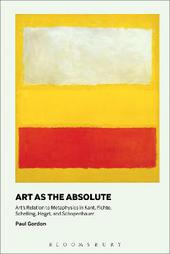
|
Art as the Absolute: Art's Relation to Metaphysics in Kant, Fichte, Schelling, Hegel, and Schopenhauer
Paperback / softback
Main Details
| Title |
Art as the Absolute: Art's Relation to Metaphysics in Kant, Fichte, Schelling, Hegel, and Schopenhauer
|
| Authors and Contributors |
By (author) Professor Paul Gordon
|
| Physical Properties |
| Format:Paperback / softback | | Pages:216 | | Dimensions(mm): Height 229,Width 152 |
|
| Category/Genre | Theory of art
Literary theory
Philosophy - aesthetics |
|---|
| ISBN/Barcode |
9781501330551
|
| Classifications | Dewey:700.1 |
|---|
| Audience | | Tertiary Education (US: College) | |
|---|
|
Publishing Details |
| Publisher |
Bloomsbury Publishing Plc
|
| Imprint |
Bloomsbury Academic USA
|
| Publication Date |
23 March 2017 |
| Publication Country |
United States
|
Description
Art as the Absolute is a literary and philosophical investigation into the meaning of art and its claims to truth. Exploring in particular the writings of Kant and those who followed after, including Fichte, Schelling, Hegel, Schopenhauer, and Nietzsche, Paul Gordon contends that art solves the problem of how one can "know" the absolute in non-conceptual, non-discursive terms. The idea of art's inherent relation to the absolute, first explicitly rendered by Kant, is examined in major works from 1790 to 1823. The first and last chapters, on Plato and Nietzsche respectively, deal with precursors and "post-cursors" of this idea. Gordon shows and seeks to reddress the lack of attention to this idea after Hegel, as well as in contemporary reassessments of this period. Art as the Absolute will be of interest to students and scholars studying aesthetics from both a literary and philosophical perspective.
Author Biography
Paul Gordon is Professor of Comparative Literature and Humanities at the University of Colorado, Boulder, USA. He is the author of The Critical Double: Figurative Meaning in Aesthetic Discourse (1995), Tragedy After Nietzsche: Rapturous Superabundance (2001), and Dial 'M' for Mother: A Freudian Hitchcock (2008).
ReviewsGerman idealism, in the boldness of its textual and systematic design, in the innovative persistence of its investigations, and in its profound, multinational repercussions, has, over the past four decades, served contemporary critical theory as a primary 'scene of interpretation.' The critical community is in Paul Gordon's considerable debt for the fresh and conclusive update delivered by Art as the Absolute on the constellation of concepts and constructs crystallizing around the Romantic figure of the artist, and on the liberties, privileges, and restrictions attending this complex and ambiguous figure. The theoretical acumen and erudition that Gordon had to derive in order to synthesize this study are prodigious; yet in its directness of approach and presentation, this current status-report is accessible to advanced scholars and motivated undergraduates alike. Gordon's fresh readings of Kant, Fichte, Schelling, Hegel, and Schopenhauer, among others, will reside at the theoretical cutting-edge for some time to come. * Henry Sussman, Visiting Professor of Germanic Languages and Literatures, Yale University, USA, and author of Playful Intelligence and The Aesthetic Contract *
|